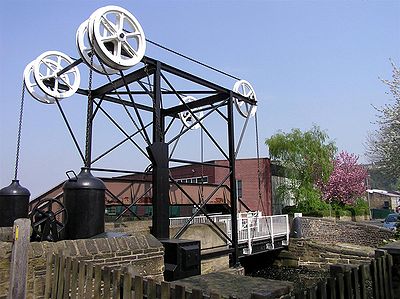
Windlass
Encyclopedia

Winch
A winch is a mechanical device that is used to pull in or let out or otherwise adjust the "tension" of a rope or wire rope . In its simplest form it consists of a spool and attached hand crank. In larger forms, winches stand at the heart of machines as diverse as tow trucks, steam shovels and...
is affixed to one or both ends, and a cable or rope is wound around the winch, pulling a weight attached to the opposite end.
Windlasses are sometimes used on boats to raise the anchor
Anchor
An anchor is a device, normally made of metal, that is used to connect a vessel to the bed of a body of water to prevent the vessel from drifting due to wind or current. The word derives from Latin ancora, which itself comes from the Greek ἄγκυρα .Anchors can either be temporary or permanent...
as an alternative to a vertical capstan
Capstan (nautical)
A capstan is a vertical-axled rotating machine developed for use on sailing ships to apply force to ropes, cables, and hawsers. The principle is similar to that of the windlass, which has a horizontal axle.- History :...
(see anchor windlass
Anchor windlass
A "windlass" is a machine used on ships that is used to let-out and heave-up equipment such as for example a ship's anchor or a fishing trawl.An anchor windlass is a machine that restrains and manipulates the anchor chain and/or rope on a boat, allowing the anchor to be raised and lowered. A...
).
The rod or stick used to tighten a tourniquet is called a windlass.
The handle used to open locks
Lock (water transport)
A lock is a device for raising and lowering boats between stretches of water of different levels on river and canal waterways. The distinguishing feature of a lock is a fixed chamber in which the water level can be varied; whereas in a caisson lock, a boat lift, or on a canal inclined plane, it is...
on the UK's inland waterways is called a windlass.
Windlasses can also be used to raise water from a well
Water well
A water well is an excavation or structure created in the ground by digging, driving, boring or drilling to access groundwater in underground aquifers. The well water is drawn by an electric submersible pump, a trash pump, a vertical turbine pump, a handpump or a mechanical pump...
. The oldest description of a well
Water well
A water well is an excavation or structure created in the ground by digging, driving, boring or drilling to access groundwater in underground aquifers. The well water is drawn by an electric submersible pump, a trash pump, a vertical turbine pump, a handpump or a mechanical pump...
windlass, a rotating wooden rod installed across the mouth of a well, is found in Isidore of Seville
Isidore of Seville
Saint Isidore of Seville served as Archbishop of Seville for more than three decades and is considered, as the historian Montalembert put it in an oft-quoted phrase, "le dernier savant du monde ancien"...
's (c. 560–636) Origenes (XX, 15, 1-3). In the Late Middle Ages
Late Middle Ages
The Late Middle Ages was the period of European history generally comprising the 14th to the 16th century . The Late Middle Ages followed the High Middle Ages and preceded the onset of the early modern era ....
European crossbow
Crossbow
A crossbow is a weapon consisting of a bow mounted on a stock that shoots projectiles, often called bolts or quarrels. The medieval crossbow was called by many names, most of which derived from the word ballista, a torsion engine resembling a crossbow in appearance.Historically, crossbows played a...
s employed a windlass as a cocking mechanism.
In the Dark Ages the windlass was also used to raise stones during the construction of cathedrals.
Differential windlass
In a differential windlass, also called a Chinese windlass, there are two coaxial drums of different radii r and r. The rope is wound onto one drum while it unwinds from the other, with a movable pulley hanging in the bightBight (knot)
In knot tying, a bight is a curved section, slack part, or loop between the two ends of a rope, string, or yarn. The term is also used in a more specific way when describing Turk's head knots, indicating how many repetitions of braiding are made in the circuit of a given knot.-Slipped knot:In order...
between the drums. Since each turn of the crank raises the pulley and attached weight by only
 , very large mechanical advantage
, very large mechanical advantageMechanical advantage
Mechanical advantage is a measure of the force amplification achieved by using a tool, mechanical device or machine system. Ideally, the device preserves the input power and simply trades off forces against movement to obtain a desired amplification in the output force...
s can be obtained.

